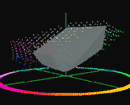การจัดการสี
โปรไฟล์ L*A*B และ ICC
สถานการณ์เวิร์กโฟลว์ที่พบได้บ่อยที่สุดในการพิมพ์สีแบบดิจิทัลอาจเป็นดังนี้: ภาพถ่ายถูกจับภาพในพื้นที่สี RGB (จากสแกนเนอร์หรือกล้องดิจิทัล) จากนั้นพิมพ์บนอุปกรณ์โดยใช้พื้นที่สี CMYK (หรือเวอร์ชันของพื้นที่สีดังกล่าว) เพื่อให้สถานการณ์ซับซ้อนขึ้นเล็กน้อย เราควรคำนึงถึงพื้นที่สี RGB ของจอคอมพิวเตอร์ที่ภาพจะแสดงและประมวลผลด้วย ช่องว่างนี้จะไม่ใช่ช่องว่างเดียวกับช่องว่าง RGB เดิม เว้นแต่เราจะดำเนินการเพื่อให้ตรงกัน

สถานการณ์ความท้าทายในการแปลงพื้นที่สีโดยทั่วไป
ถึงแม้จะมีรูปแบบสถานการณ์จำลองนี้ได้อย่างไม่มีที่สิ้นสุด แต่สถานการณ์จำลองนี้ก็ถือเป็นความท้าทายพื้นฐานสำหรับเวิร์กโฟลว์เชิงพาณิชย์จำนวนมาก กล่าวอย่างง่ายๆ ก็คือ ปัญหาอยู่ที่ว่าจะแปลข้อกำหนดสีที่ขึ้นอยู่กับอุปกรณ์เหล่านี้จากช่องสีต้นฉบับไปยังช่องสีเอาต์พุตและทำให้การพิมพ์ขั้นสุดท้ายมีลักษณะเหมือนต้นฉบับมากที่สุดได้อย่างไร สิ่งที่เราต้องการคือวิธีที่จะอนุญาตให้ช่องสีที่ขึ้นอยู่กับอุปกรณ์เหล่านี้สื่อสารกันได้
L*a*b*—พื้นที่สีอิสระ
คำตอบคือช่องสี L*a*b* ซึ่งเป็นช่องสีอิสระจากอุปกรณ์ที่ให้มาตรฐานอ้างอิง "สากล" แบบจำลองสีทางวิทยาศาสตร์นี้ได้รับการพัฒนาในปีพ.ศ. 2474 โดยองค์กรที่เรียกว่า Commission Internationale de l'Eclarage หรือที่รู้จักกันดีในชื่อ CIE
พื้นที่ CIE L*a*b* กลายมาเป็นมาตรฐานโดยพฤตินัยที่อุปกรณ์และกระบวนการต่างๆ ที่ใช้ในงานศิลปะกราฟิกสื่อสารกันในแง่ของข้อมูลสี ลองนึกถึงพื้นที่ L*a*b* เป็นเหมือนนักแปลที่มีหลายภาษา แม้ว่าอุปกรณ์เครื่องหนึ่งจะพูดได้แค่ RGB และอีกเครื่องหนึ่งพูดได้แค่ CMYK แต่เครื่องแปล L*a*b* สามารถเข้าใจทั้งสองแบบและช่วยอำนวยความสะดวกในการสื่อสาร
L*a*b* ทำงานอย่างไร
หนึ่งในความแตกต่างระหว่าง L*a*b* กับ RGB และ CMYK ก็คือ L*a*b* ไม่ใช้ชุดสีหลักแบบอัตนัย ซึ่งหมายความว่าจะไม่ผูกติดกับชุดหมึกเฉพาะ (เช่นที่อาจพบในเครื่องพิมพ์อิงค์เจ็ท) หรือกับฟอสเฟอร์ประเภทใดประเภทหนึ่งโดยเฉพาะ (เช่น สารที่สร้างสีบนหน้าจอมอนิเตอร์ของคุณ)
ปริภูมิ L*a*b* อธิบายสีด้วยตำแหน่งตามแกน 3 แกนในปริภูมิสี 3 มิติ แกน L แสดงถึงความสว่างหรือความสว่างของภาพ ซึ่งเป็นการวัดเนื้อหาสีขาวถึงสีดำของสีใดๆ ก็ได้ แกน a วิ่งจากสีแดงไปยังสีเขียว และแกน b วิ่งจากสีเหลืองไปยังสีน้ำเงิน

| ตำแหน่งในพื้นที่ L*a*b* ถูกกำหนดดังต่อไปนี้: → ค่า L จาก 0 (ดำทั้งหมด) ถึง 100 (ขาวทั้งหมด) → ตำแหน่งบนแกน a ช่วงตั้งแต่ -128 (สีเขียว) ถึง 127 (สีแดง) → ตำแหน่งบนแกน b ช่วงตั้งแต่ -128 (สีน้ำเงิน) ถึง 127 (สีเหลือง) |
สีใดๆ ก็สามารถอธิบายได้ทางคณิตศาสตร์ โดยการกำหนดตำแหน่งภายในพื้นที่ทางกายภาพสามมิตินี้ ค่า L*a*b* ของสีจะได้มาจากการวัดสีด้วยเครื่องวัดสีหรือเครื่องวัดสีแบบสเปกโตรโฟโตมิเตอร์ ความแตกต่างระหว่างสีสามารถระบุได้จากระยะห่างระหว่างสี ระยะห่างนี้บางครั้งจะถูกกำหนดโดยใช้เดลต้า E ซึ่งคือปริมาณความแตกต่างของสีขั้นต่ำระหว่างสองเฉดสีที่สามารถมองเห็นได้ด้วยตาเปล่า
โปรไฟล์สี ICC
โปรไฟล์สีคือคำอธิบายความสัมพันธ์เชิงตัวเลขระหว่างช่องสีสองช่อง โปรไฟล์สีที่เราจะพูดถึงคือโปรไฟล์ ICC โปรไฟล์ ICC คือคำอธิบายของพื้นที่สีในแง่ของค่า L*a*b* ICC ย่อมาจาก International Color Consortium ซึ่งเป็นกลุ่มบริษัทสำคัญ 8 แห่งในธุรกิจสี
| สมาชิกผู้ก่อตั้ง | สมาชิกสามัญที่ได้รับการคัดเลือก |
| ระบบอะโดบี อักฟา กาแวร์ต คอมพิวเตอร์แอปเปิ้ล อีสต์แมน โคดัก บริษัท ไมโครซอฟต์ ซิลิคอน กราฟฟิก ซันไมโครซิสเต็มส์ |
ความรู้เรื่องสี ครีโอไซเท็กซ์ การพิสูจน์สีดูปองต์ ฟิล์มถ่ายรูปฟูจิ Gretag Macbeth เครื่องจักรไฮเดลเบิร์ก บริษัท แพนโทน อิงค์ |
จากความพยายามร่วมมือระหว่างองค์กรที่ประสบความสำเร็จมากที่สุดแห่งหนึ่ง องค์กรนี้ได้สร้างแนวคิดโปรไฟล์ ICC ให้เป็นเกมเดียวในเมืองในแง่ของการจัดการสีทางวิทยาศาสตร์ แม้ว่าบริษัทต่างๆ จะมีการใช้งานโปรไฟล์ ICC ที่เป็นกรรมสิทธิ์ แต่มาตรฐานสำหรับโปรไฟล์สี ICC ถือเป็นทรัพย์สินสาธารณะ นี่เป็นสิ่งที่ใกล้เคียงกับมาตรฐานในทางวิทยาศาสตร์ที่ส่วนใหญ่เป็นเรื่องอัตวิสัยเช่นสีมากที่สุด
โปรไฟล์สีอาจอธิบายช่องสีหลายประเภท โปรไฟล์เอาต์พุตอาจเป็นสิ่งที่คุ้นเคยที่สุด ซึ่งควรมีปัจจัยทั้งหมดที่ส่งผลต่อการพิมพ์ ตัวอย่างเช่น ในการพิมพ์อิงค์เจ็ท โปรไฟล์เอาต์พุตที่สมบูรณ์จะประกอบด้วยชุดหมึก สื่อที่พิมพ์ได้ เครื่องพิมพ์ การตั้งค่าทั้งหมด เส้นโค้งเชิงเส้น รูปแบบการคัดกรอง และอื่นๆ
โปรไฟล์อินพุตอาจอธิบายเงื่อนไขอินพุตสำหรับ RGB, CMYK หรือช่องสีอื่นๆ ได้ด้วย โปรไฟล์อินพุตทั่วไปได้แก่ โปรไฟล์สแกนเนอร์ โปรไฟล์มอนิเตอร์หรือพื้นที่ทำงาน หรือโปรไฟล์ CMYK สำหรับสีจุดขาเข้า สำหรับการจำลองการพิสูจน์ ยังสามารถใช้โปรไฟล์เอาต์พุตเป็นโปรไฟล์อินพุตได้อีกด้วย
โปรไฟล์ทำงานอย่างไร
ในรูปแบบที่ง่ายที่สุด โปรไฟล์จะประกอบด้วยตารางสีชุดหนึ่ง ตารางด้านล่างนี้แสดงตัวอย่างสีจากเครื่องสแกน RGB สมมติฐานและค่าเทียบเท่า L*a*b*
| สี | อาร์จีบี | ซีไออี แอลเอบี |
| สีแดง | 203,0,23 | 50, 71, 54 |
| สีน้ำเงินเข้ม | 0,46,160 | 32, 34, -71 |
| สีเหลือง | 255,243,0 | 95, -17, 99 |
| สีเขียว | 0, 139, 74 | 56, -81, 32 |
ตารางถัดไปแสดงสีเดียวกันที่พิมพ์ใน CMYK และวัดด้วยเครื่องวัดสี
| สี | Cmyk | ซีไออี แอลเอบี |
| สีแดง | 203,0,23 | 50, 71, 54 |
| สีน้ำเงินเข้ม | 0,46,160 | 32, 34, -71 |
| สีเหลือง | 255,243,0 | 95, -17, 99 |
| สีเขียว | 0, 139, 74 | 56, -81, 32 |
การรวมตารางเหล่านี้เข้าในโปรไฟล์ลิงก์จะสร้างตารางด้านล่างนี้ โดยพื้นฐานแล้วนี่คือวิธีที่ Wasatch SoftRIP รับประกันความแม่นยำของสีสำหรับสถานการณ์การพิมพ์มาตรฐานแทบทุกสถานการณ์ที่ผู้ใช้ของเราอาจพบเจอ
| อาร์จีบี | ซีไออี แอลเอบี | Cmyk |
| 203, 0 23 | 50, 71, 54 | 0, 100, 91, 0 |
| 0, 46, 160 | 32, 34, -71 | 100, 69, 0, 0 |
| 255, 243, 0 | 95, -17, 99 | 6, 0, 91, 0 |
| 0, 139, 74 | 56, -81, 32 | 100, 0, 79, 0 |
ในทางปฏิบัติ โปรไฟล์ ICC ประกอบด้วยส่วนประกอบหลักสองส่วนคือส่วนหัวและแท็ก ส่วนหัวจะระบุเพียงประเภทของโปรไฟล์ แท็กนี้จะกำหนดการแปลงเชิงตัวเลขระหว่างพื้นที่สีเป้าหมายและค่า L*a*b* นอกจากนี้ โปรไฟล์ยังรวมถึงเจตนาในการเรนเดอร์ ซึ่งเป็นวิธีการจับคู่สีที่ใช้ในรูปภาพด้วย บทความของเราเกี่ยวกับ การแสดงผลเจตนา จะอธิบายรายละเอียดเพิ่มเติมเกี่ยวกับหัวข้อนี้
